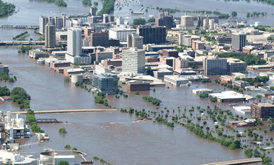Floods
Why in the news?
A study led by the World Bank, published in Nature, highlights the increasing flood risk in many Indian cities due to urban expansion into flood-prone areas.
The Study
- Since 1985, human settlements in flood-prone regions have more than doubled, indicating unsustainable urbanization practices in India.
- Middle-income countries, such as India, have a higher number of urban settlements in flood-prone zones compared to low- and high-income nations.
- India ranks third in terms of global settlements contributing to this issue, after China and the U.S., and third among countries with new settlements expanding into flood-prone areas.
- Researchers, from WRI India, emphasize the significant risk of flood-related problems in India, particularly for informal settlements in low-lying areas.
- The expansion of urban areas into flood-prone zones is a result of inadequate governance processes that do not address environmental sustainability.
- Existing regulations tend to focus on large infrastructure projects rather than smaller-scale modifications in localities.
- This expansion overlooks the local topography, posing a threat to people’s lives and property.
- The study raises concerns about the need for improved urban planning and governance to mitigate flood-related risks, especially in informal, low-income housing areas.
Urban Floods
- Urban floods are inundations that occur in densely populated areas, typically cities and towns.
- They result from heavy rainfall, inadequate drainage systems, and increased urbanization.
- Urban areas often have impermeable surfaces like roads and buildings, preventing water absorption and leading to rapid runoff.
- Inefficient city planning and inadequate flood management exacerbate the problem, causing waterlogged streets, damaged infrastructure, and health risks.
- Climate change further intensifies urban floods.





